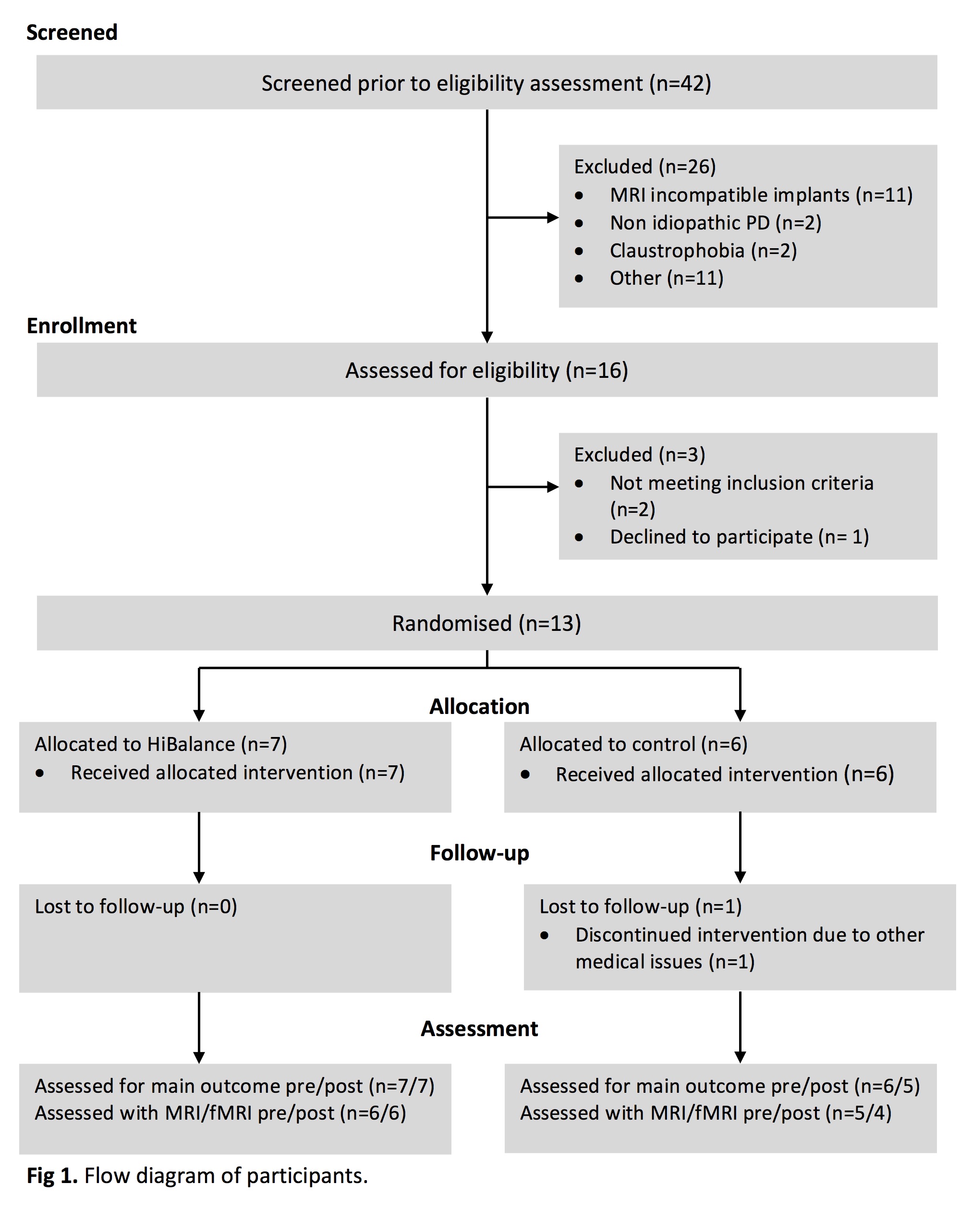Session Information
Date: Monday, October 8, 2018
Session Title: Parkinson's Disease: Neuroimaging And Neurophysiology
Session Time: 1:15pm-2:45pm
Location: Hall 3FG
Objective: The aim of this pilot study was to explore trial design and to assess feasibility and acceptability of the data collection methods and the interventions.
Background: Highly challenging balance training (the HiBalance program) has been shown to improve gait and balance in Parkinson´s disease (PD) (1). To explore whether these improvements can be linked to neuroplastic changes in the brain, a trial design incorporating functional magnetic resonance imaging (fMRI), and plasma sampling, was developed.
Methods: The study was a parallel-group RCT pilot with an equal 1:1 allocation ratio to either the HiBalance group or a control group (speech- and communication therapy). Participants with idiopathic PD were recruited via advertisement and were eligible for inclusion when 60 years of age; Hoehn & Yahr stage 2-3 and 21 on Montreal Cognitive Assessment. Blinded assessors performed pre- and post testing of motor symptoms and gait- and balance performance (main outcome Mini-BESTest). Neuroplastic changes were monitored using fMRI, MRI and plasma-BDNF. The same training dose was used in both groups and consisted of one-hour sessions twice a week, plus home exercises once a week, for 10 weeks. Feasibility aspects included eligibility criteria and recruitment rate; blinding process; experimental setup and image quality of the fMRI/MRI assessment; and participant acceptability of the interventions. Adverse events were monitored.
Results: [figure1] See Fig 1 for a flow diagram of participants. A total of 13 participants were included (4 women; mean age 69.7; mean MDS-UPDRS III score 34.4), with a recruitment rate of 31.0%. During MR-scanning, problems with diplopia and/or sleepiness were observed in several participants. Structural images of two participants were evaluated to be of low quality. Attendance rates for the HiBalance and the control group were 84.3% and 90.0% respectively. Two adverse events were reported in the HiBalance group (two non-injurious falls) and one in the control group (pre-existing strained-strangled voice).
Conclusions: The overall trial design proved feasible and acceptable, with satisfactory attendance and drop-out rates. However, a few revisions to the MR-scanning will be beneficial to obtain high-quality data in a definite RCT, including efforts to minimize the risk of diplopia and sleepiness.
References: 1. Conradsson D, Löfgren N, Nero H, Hagströmer M, Ståhle A, Lökk J, et al. The Effects of Highly Challenging Balance Training in Elderly With Parkinson’s Disease. 2015;29(9):827-36.
To cite this abstract in AMA style:
H. Johansson, M. Hagströmer, U. Ekman, B. Leavy, M. Freidle, E. Schalling, P. Svenningsson, E. Franzén. Feasibility aspects of evaluating neuroplastic changes after balance training in Parkinson´s disease: A pilot randomised controlled trial [abstract]. Mov Disord. 2018; 33 (suppl 2). https://www.mdsabstracts.org/abstract/feasibility-aspects-of-evaluating-neuroplastic-changes-after-balance-training-in-parkinsons-disease-a-pilot-randomised-controlled-trial/. Accessed December 12, 2025.« Back to 2018 International Congress
MDS Abstracts - https://www.mdsabstracts.org/abstract/feasibility-aspects-of-evaluating-neuroplastic-changes-after-balance-training-in-parkinsons-disease-a-pilot-randomised-controlled-trial/

